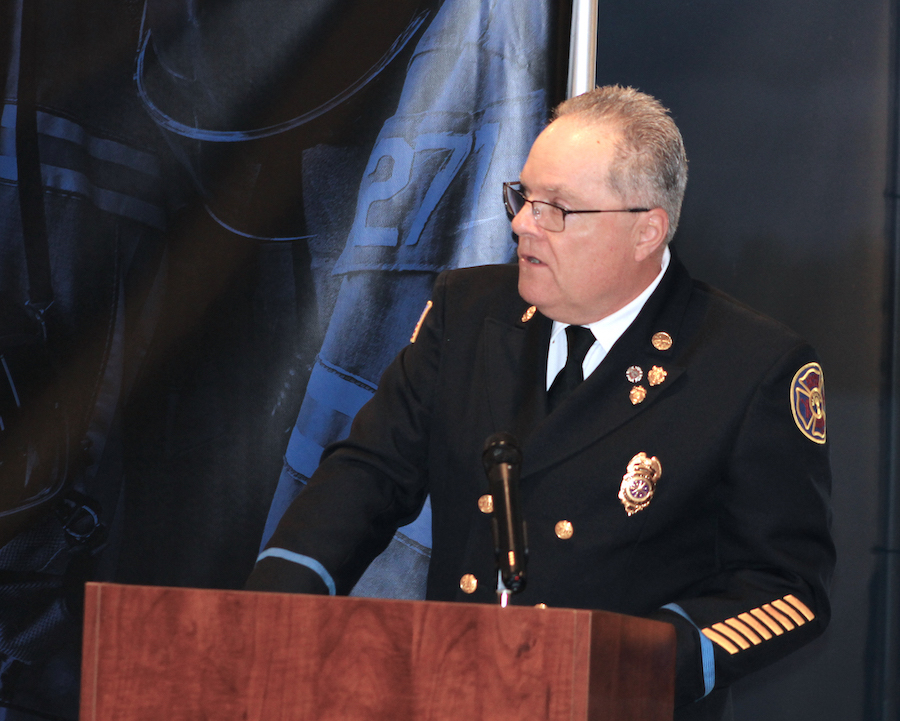Featured News - Current News - Archived News - News Categories
David Holmes is a wilderness medicine expert and director of global health education in Jacobs School of Medicine and Biomedical Sciences
By the University at Buffalo
Western New Yorkers have seen plenty of winter storms, but it’s important to take into account certain factors about the one that barreled through our region this weekend, according to David Holmes, M.D., clinical associate professor of family medicine in the Jacobs School of Medicine and Biomedical Sciences at the University at Buffalo. And that’s true, whether they plan to attend the Bills game in Orchard Park that has now been rescheduled for Monday afternoon or they plan to stay home.
Holmes is a wilderness medicine expert and, as director of global health education in the Jacobs School, he leads medical students and professionals on medical missions to remote areas throughout the globe; he is a physician with UBMD Primary Care.
•Who, in particular, is especially vulnerable to being outside in the cold for long periods, and therefore should avoid attending the game or being outside at all?
The elderly, children, and those with chronic heart or lung problems (such as asthma) are most susceptible to cold weather. They can more easily get hypothermia and frostbite, and the cold can trigger heart attacks and asthma/COPD exacerbations. That’s the case especially if there’s exertion, such as climbing stadium steps. Individuals in these vulnerable groups should stay indoors.
•If you are relatively healthy, what can you do to stay safe while attending the game on Monday?
Anyone who is outside in frigid temperatures for more than about 15 minutes is at high risk of developing hypothermia and frostbite. Most of our body is made up of water, and the water inside our skin cells can freeze, which causes frostbite and may result in permanent tissue damage. Getting frostbite depends on the temperature and wind chill factor. For instance, if it’s zero degrees Fahrenheit and the wind is 15 mph, then frostbite can set in after only 30 minutes of cold exposure.
•How to dress:
The prolonged cold exposure from watching a Bills game in frigid temperatures puts fans at high risk of hypothermia and frostbite. To try to decrease this risk, it’s best to wear plenty of layers of warm clothes (wool, fleece, and synthetic materials such as polyester and elastane). Avoid cotton, because it does not wick away moisture and does not insulate well. Wearing layers is important because the air between the layers provides added insulation.
•How to insulate your feet, hands and head:
Your feet, hands and face are most susceptible to cold and frostbite. Therefore, wear two pairs of wool socks on each foot and boots to keep your feet warm. Wool socks keep your feet much warmer and drier than other materials. Wool mittens are best for keeping hands warm, too. Battery-operated hand warmers are also helpful. Wear a warm hat that covers your ears and a scarf that covers your face, so that only your eyes are showing. Bring a cushion for added insulation so that you don’t lose as much body heat from sitting on cold seats. If someone starts shivering a lot, slurring their speech, acting a bit confused, or having balance problems, they should get inside immediately and get warmed up, as those are symptoms of hypothermia.
•How can people keep themselves safe indoors during the storm, even if there is a temporary power outage?
The National Institute on Aging (NIA) has good recommendations for older adults, which are also applicable to all age groups. They include:
√ Set the thermostat to 68°F or higher, assuming no outage has occurred. Lower temperatures indoors could gradually create chilly conditions and, if sustained for long periods, could even lead to hypothermia. (Resources that might help with heating bills are available through the National Energy Assistance Referral service at 1-866-674-6327.)
√ Close off rooms not in use.
√ Keep the basement door closed.
√ Keep blinds and curtains closed to decrease heat loss through windows. If there are gaps around the windows, use weather stripping or caulk to keep the cold air out.
√ Stuff towels or rags in cracks under doors to prevent drafts.
•What should people do in terms of dressing and eating during the storm to stay healthy?
√ Dress warmly even indoors. Wear socks and slippers.
√ When going to sleep, wear long underwear and use extra covers.
√ Eat enough food to keep weight up. Food provides the body with energy for producing its own heat.
√ Drink plenty of water and nonalcoholic drinks to prevent dehydration since cold air is very dry.
√ Alcoholic drinks can cause the loss of body heat, so drink moderately or not at all.
√ Wear layers of loose-fitting, lightweight, warm clothing, but remove layers to avoid overheating, perspiration and subsequent chill.
√ Stay in touch with family or friends to check in during the storm.
√ Shoveling is never recommended for older adults and those with underlying health conditions. The combination of overexertion and cold puts older people at high risk for heart attacks when shoveling snow.
•What is frostbite?
Frostbite is an injury to the body that is caused by freezing. It results in a loss of feeling (numbness, tingling), aching and loss of color in the affected areas. It usually affects toes, fingers, nose, ears, cheeks and chin. It can permanently damage body tissues and, in severe cases, may lead to the need for amputation. Never rub an area of the body that may have frostbite, as that may cause skin damage.
•What is hypothermia?
Hypothermia is a medical emergency when the body loses heat faster than it can produce it. Drinking alcohol and being wet can cause hypothermia to occur more quickly. Increased body fat adds extra insulation (one of the few health benefits of obesity).
Being wet is a significant problem since water conducts heat away from the body 25 times faster than air. Therefore, hypothermia develops much more quickly. According to the U.S. Coast Guard, if you fall into water that is 33-40 degrees, you’ll likely become exhausted or unconscious in 15-30 minutes and likely will die in 30-90 minutes.
•What are the symptoms of hypothermia?
Symptoms of hypothermia are:
√ Feeling cold to the touch especially in hands and feet, pale skin, shivering, slower speech, slurring words, confusion, making irrational decisions (such as going outside with few clothes on), and problems with balance.
√ Symptoms of advanced hypothermia include slow heartbeat, shallow breathing, and loss of consciousness. Call 9-1-1 immediately if anyone has these symptoms.
√ Before medical help arrives, try to warm the person with blankets and coats and warm liquids, such as hot chocolate.
•What kinds of injuries may impact local emergency rooms as a result of the storm?
The ERs will likely be seeing cases of hypothermia and frostbite; car crash injuries due to icy roads, snow and poor visibility; and exacerbations of chronic diseases, especially cardiac and respiratory conditions since the cold can precipitate breathing problems and heart attacks.
The views and opinions expressed in this commentary are based on the opinions and/or research of the faculty member(s) or researcher(s) quoted, and do not represent the official positions of the University at Buffalo or Niagara Frontier Publications.





























